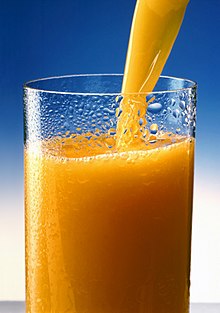Juice

The juice is a liquid beverage stored inside different fruits and vegetables, which is used by pressure. Many times, the juice refers to the liquid substances derived from these vegetables (fruits or vegetables), or other organic food sources such as meat and marine food (for example, mussel juice). Generally, juice is also used as a type of beverage or as a flavorful ingredient in other foods or beverages. The process of preparing fermentation ([[vintage alcohol]] after the introduction of juice in the pasutan process without processing, the juice arises as a beverage of choice of the common people. According to the United States Food and Agriculture Organization (FAO), in 2012, 12,840,318 tons of citrus fruit juice is produced all over the world. [1] The largest consumer of fruit juice is New Zealand (about a cup or 8 oz per day) and Colombia (more than three quarters of a cup per day). With the increase in the average income of a country, the amount of fruit juice receipts increases.
Etymology editing
Fruit juice is used in making a smoothie
The word juice comes from the Old French word 1300. Its original French word is 'jus', juis, jouis '' which means 'the liquid derived from boiling the bush'. [2] From the beginning of the 14th century the word "Juice" Inner fluid "is used to mean. It is not known when the word 'Ross' is derived from Bengal.
Preparation for editing
In the absence of thermal application and absence of drip, fruits or vegetables are mechanically crushed and made into juice. For example, orange juice is the extract of orange tree fruit, tomato juice is mixed with the pressure from the fruit of the tomato tree and brought out. The juice from fruits or vegetables can be prepared through the use of hand or juice in the house. In the commercial field, a lot of time is removed from the juice to remove the scalp or the marrow. But on the other hand, the more waxy orange juos again popular drinks. Often, sugar, artificial flavor and odor are added to the juice. Among the many methods of preserving juice are notable, such as bottling, pustulation, concentration, freezing etc.
Although there is a difference in the method of preparing the juice according to the nature of juice, the typical method of preparing the juice is as follows: [3]
Washing and sorting
Juice extraction
Filter, filtration and purification
Mixing and Pasteurine
Bottling
Cooling and packaging
After collecting and washing fruit, juice is separated from fruit by one of two automated methods. The first method combines two metallic cups with the metal tube, leaving the fruit peel and the fruit mazes are pressed through the metal tube. As a result, the juice of the juice from the small holes inside the tube becomes out. Fruit peas are kept for later use. According to the second method, before the production of the machine, the fruit will be extracted before the fruit is cut into two parts in two parts. [4]
After the absorption of the juice, it is concentrated in vaporization. The volume of the volume is divided into five parts. In this, the juice is easy to transport, as well as its expiration time and prolongation. The juice is coated with heat in the absence of moisture so that the water content of rosemary is removed. Two thirds of the juice is removed from the water. After the juice is again regenerated. Dense juice is mixed with necessary water and other issues such as lost taste and smell are brought back. In many cases, the condition of solid condition is sold, in this case, the need to mix the necessary water during the use of the consumer.
The juice is then pudding and it is festooned, sometimes in hot conditions. If the juice is kept in the juice, then it is cool as soon as possible. [Link]
This post has received a 0.20 % upvote from @drotto thanks to: @kingparvez.